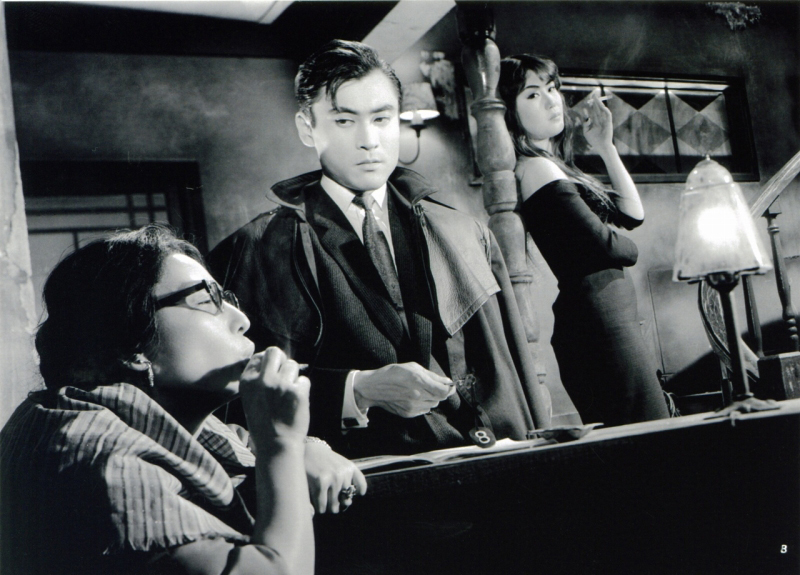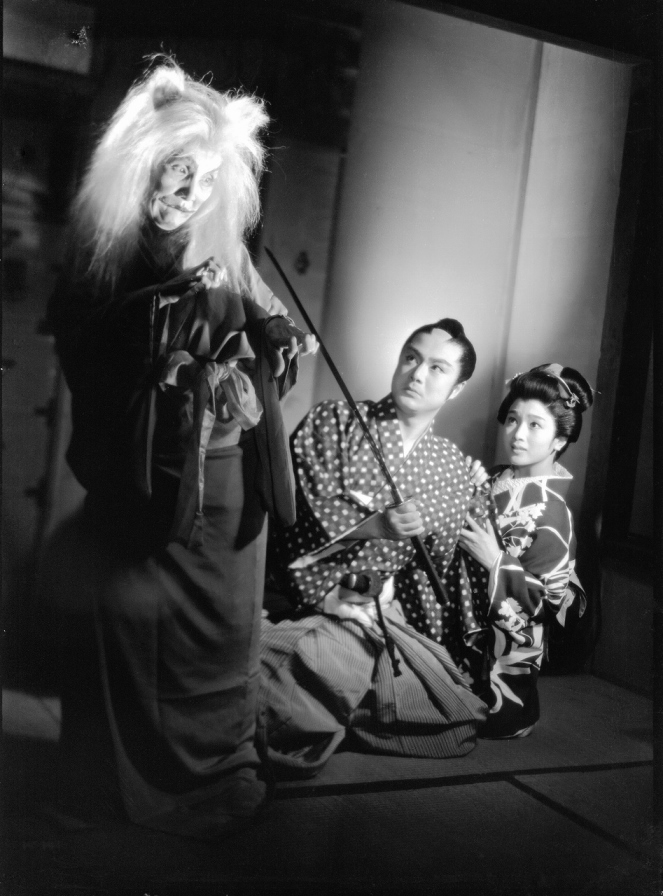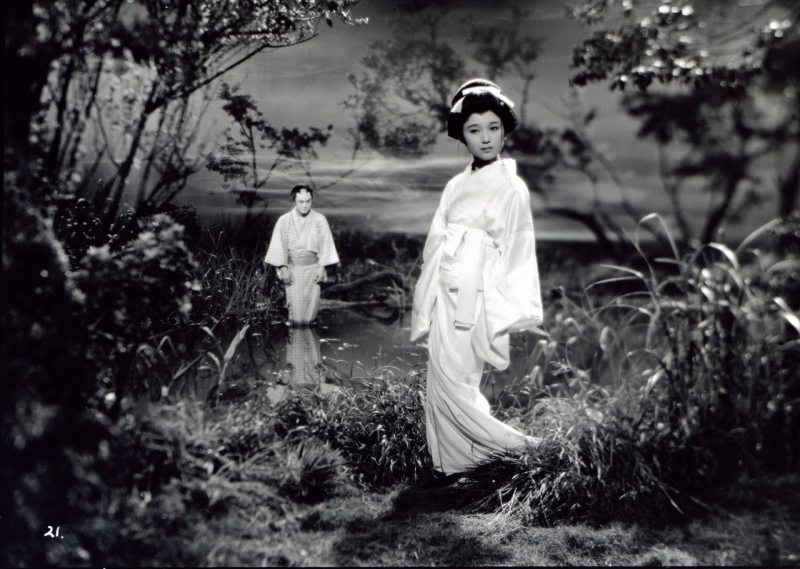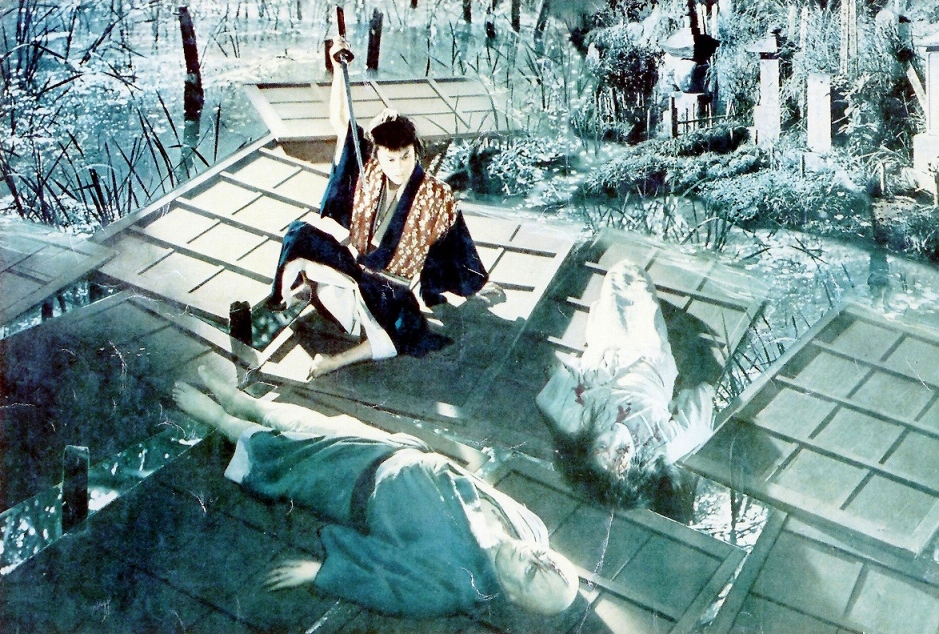By Christopher Bourne
Japan Society’s film series “Into the Shintoho Mind Warp: Girls, Guns & Ghosts from the Second Golden Age of Japanese Film” screens from February 27 through March 10.
This series of eight films focuses on the exploitation films – horror, gangster, crime, and sexploitation productions – of Shintoho Studios, the smallest of the six major studios (the others were Daiei, Nikkatsu, Shochiku, Toei, and Toho) active in Japan in the 1950s and 1960s. Shintoho came into existence as an offshoot of Toho Studios, started by former employees of Toho who left after labor disputes. Shintoho began by releasing films by some of the masters of Japanese cinema, including Ozu, Kurosawa, Mizoguchi, Naruse, and Ichikawa. However, in the mid 1950’s, under the leadership of Mitsugu Okura, a former carnival showman, the studio’s focus turned to much less respectable low-budget genre and exploitation films, many of which fell under what was known as the “ero-guro” or “erotic grotesque” genre. Shintoho Studios finally collapsed after going bankrupt in 1961. Japan Society’s series concentrates on the final years of the studio, with such highlights as “Vampire Bride” (screening March 2, 5:15) and “Revenge of the Pearl Queen” (March 3, 7pm), which is famous for having the first nude scene ever in Japanese cinema history. The three films I review below are very interesting examples of the sort of films that were put out at the studio in this period.
Based on a famous 1825 kabuki play that has been adapted numerous times, Nobuo Nakagawa’s 1959 film “Ghost Story of Yotsuya” (February 27, 8pm) encapsulates many of the stylistic elements that distinguished Shintoho horror film productions of this period: expressively lurid red and green colors, a widescreen frame drenched in creepy shadows. Preserving the theatrical staging of its source material, Nakagawa’s film also contains elements of Shakespeare’s “Macbeth” and Greek tragedy. It tells the tale of Iemon (Shigeru Amachi), a low-ranking samurai who wishes for the hand of the beautiful Iwa (Katsuko Wakasugi). When Iwa’s father in no uncertain terms refuses to let his daughter marry Iemon, he murders Iwa’s father in a sudden rage. With the help of his servant and fellow accessory to murder Naosuke (Emi Shuntaro), he is able to frame someone else for the murder and pretends to seek vengeance. However, their marriage is not a happy one: Iemon’s low status imposes upon them a life of poverty, which he sees a way out of when he insinuates himself into the family of Ume (Junko Ikeuchi), a woman he saves from some thugs. Iemon now wants to marry Ume, but of course his present wife is now in the way. Iemon slips poison into her medicine and tries to set her up as an adulterer with a masseur. One of the most striking scenes in the film occurs as Iwa’s face becomes grotesquely twisted from the poison; the bloody streaks left when she tries to comb her hair is the capper detail. When she finds out that Iemon has murdered her, she vows revenge, which she does by returning to haunt him and setting in motion a series of events that eventually lead to his destruction and comeuppance for his crimes. Nakagawa paints everything in boldly lurid and unsubtle strokes; the slow and careful setup pays great dividends in expressive scenes of horror that proved to be quite influential to later genre filmmakers.
Ghost Cat of Otama Pond (Yoshiro Ishikawa, 1960)
“Ghost Cat of Otama Pond,” (March 1, 7pm) directed in 1960 by Yoshiro Ishikawa – who apprenticed at Shintoho under Nobuo Nakagawa – makes use of several stylistic elements of Nakagawa’s films: expressive use of reds and greens, creepy atmospherics with an eerie score, and scenes of ghost-driven vengeance. A sort of Romeo and Juliet story set in feudal Japan, the film begins in the present day, as a young couple – Tadahiko (Shozaburo Date) and Keiko (Noriko Kitazawa) – are on their way to Tadahiko’s parents’ house to announce to them his intention to marry Keiko. He decides to take a shortcut through the woods that he thinks will get them there faster, but instead, regardless of whatever path they take, they keep getting drawn to the area that includes the titular pond. There seems to be some mystical force drawing them there. As it is beginning to get dark, they seek shelter by following a black cat (which Keiko recoils at the sight of), leading them to an abandoned mansion. While there, Keiko sees a vision of a ghostly old woman that causes her to pass out and fall into a deep coma. A visiting priest examines her and tells Tadahiko that her coma is the result of a curse, transmitted through black cats, that involves both their ancestors. The priest relates the story, which takes up the bulk of the screen time, about star-crossed lovers (also played by Shozaburo Date and Noriko Kitazawa), their warring families, and the succession of murders, acts of revenge, and ghostly comeuppance for crimes, leading to the curse that continues to this day, and which the priest must exorcize out of Keiko’s body. Ishikawa’s bold theatrics and lurid color schemes greatly enhance the effect of this centuries-spanning horror tale.
Teruo Ishii’s 1960 film “Yellow Line” (March 10, 4pm), the third in his “Line” series of noir films, is a lively, engaging, and quite strange look at the underground sex and crime-ridden atmosphere of the port city of Kobe. Gangsters, drug dealers, junkies, pimps crowd together in teeming, narrow alleyways, docks, and seedy nightclubs; Ishii paints a vivid picture of this dangerous and alluring milieu. “Yellow Line” concerns a hitman (Shigeru Amachi), who is betrayed by his employer, who calls the police on him after he does his contract killing. He kidnaps Emi (Yoko Mihara), who is on her way to a new job at a nightclub. They travel to Kobe, where the hitman is looking for the people who sent him on the job. Emi’s reporter boyfriend Mayama (Teruo Yoshida), tipped off by finding Emi’s shoe on a train platform, follows them to search for Emi and to uncover the details of a prostitution ring that kidnaps Kobe office ladies for human trafficking purposes. “Yellow Line” boasts engaging performances and an appropriately lurid mise-en-scene that makes for a memorable close to this series.
Trailer: http://www.youtube.com/watch?v=yZZD-WW879s
For more information on this series, and to purchase tickets, visit Japan Society’s website: www.japansociety.org.





Leave a Reply